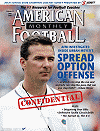AMERICAN FOOTBALL MONTHLY THE #1 RESOURCE FOR FOOTBALL COACHES
Article CategoriesAFM Magazine
|
Point Counterpoint - The Spread Offense vs the 4-3by: David Purdum© More from this issue The spread offense has become a potent weapon, especially in the college and high school ranks. It forces teams to defend the entire field, while also putting an offenseís best athletes in open space. But what if itís the defense that possesses the best athletes? What if their 6-foot-1, 200-pound All-American corner continually gobbles up your 5-foot-10, 175-pound receiver? What if your offensive line and empty backfield canít handle even just the defenseís front four? Is it time to trade in the five-wide set for two tight ends and an I formation? No, says Mission Viejo High School head coach Bob Johnson. But adjustments have to be made when youíre facing a defense with superior athletes. The same goes for defenses facing the spread, said Duquesne head coach Jerry Schmitt. Adjustments have to be made to counte....The full article can only be seen by subscribers. Subscribe today!
|
|
|||||||
| HOME |
MAGAZINE |
SUBSCRIBE | ONLINE COLUMNISTS | COACHING VIDEOS |
Copyright 2025, AmericanFootballMonthly.com
All Rights Reserved





